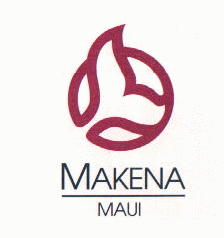By Jeffrey A. Rendall, Photos By Jeffrey A. Rendall and Chuck Rendall
|
|
MAKENA, MAUI, HI – “I’ve had lots of people tell me they enjoyed the North Course,” remarked Kirk Nelson, Makena Golf Courses’ Head Golf Professional. “But then one time there was this English chap who described a trip around it as ‘delicious.’ I’ve had a hard time finding a better way to put it after that.”
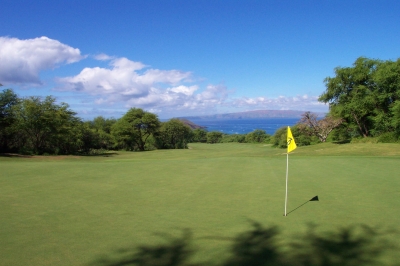 |
| Looking back from the par five 10th hole's green. At this point you're near the top of the course, with views to match. |
Whether you think of it in the tasty sense or not, playing at Makena is vintage Hawaiian golf – and its North Course was, in our opinions, the most beautiful and scenic of the bunch. Considering we’d played on different parts of the island of Maui and journeyed to Lanai as well, that’s saying a lot. At Makena North, there’s more of everything – more mountains, more deep blue ocean views, more elevation changes, more challenge, more foliage and dare I say it… more aggravation as well. There’s a whole ‘nother range of emotions you get from playing here – no wonder it’s quietly the informed Maui visitors’ favorite course.
The North Course is actually a combination of two nines – the first half (actually 1-5 and 15-18) of its holes opened in 1982, sculpted by noted architect Robert Trent Jones Jr., with the second nine coming ten years later, winding up, down and through the foothills of Haleakala volcano – the earlier links also designed by Jones Jr. Like you’d expect, the North is very much resort-style golf, but its distinction from other Hawaiian golf course cousins lies in the sense of isolation you feel on the layout.
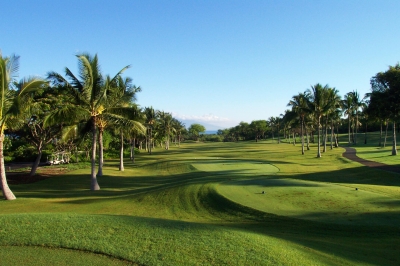 |
| Shadows obscure the relatively tame opening hole, a 419-yard par four. |
As you make your way up the hills, finding your apex on the 10th green, there’s not a house, condo or hotel around. It’s you, the golf course, and the Pacific Ocean at your back. On the holes that move parallel to the water, then back down the slope, Jones Jr. lined up the Molokini crater or the Island of Lanai to focus your aim. There’s a little different view on every shot, and it’s just captivating to experience.
The North Course shares the Makena spotlight with the South Course, the other Jones Jr. designed layout on the property – featuring three holes along the ocean. The Makena Resort itself is comprised of 1,800 acres of prime coastal land, located just south of the more well-known Wailea area. The courses are owned and operated by Maui Prince Resorts, which offers 310 rooms of quiet luxury on the beach to recuperate after a day of… relaxing.
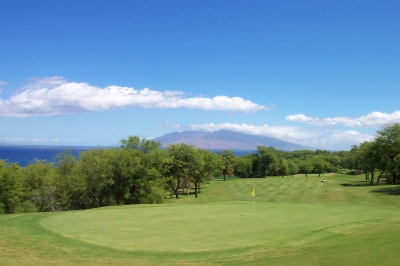 |
| Even on the lower portion of the course, it's still designed to give you terrific looks -- you can see Western Maui from the green of the par four 16th hole. |
The land itself was once used as a sugar plantation, then a cattle ranch – originally owned by legendary Scottish sea captain James Makee (who’s even got a Hula dance named after him). The Hawaiian word Makena means ‘bountiful,’ and the land’s natural gifts contributed to its value for raising prize beef until 1949. In more contemporary times, the region is known for its sandy beaches (Oneloa, called ‘Big Beach,’ is over 3,000 feet long and 100 feet wide), luxurious vacation resorts and of course, great golf.
Unlike more developed parts of Maui and the other Hawaiian islands, it’s not overrun with tourists, lending itself to a more relaxed attitude, which is certainly reflected in the staff, and the fact the golf course was lightly patrolled and virtually devoid of humanity on the day we played. Prior to doing some research, we’d never even heard of Makena – and now that the secret’s out, it’s someplace we’ll look to visit again.
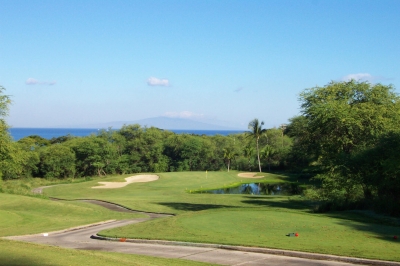 |
| The North Course is challenging -- the short, downhill par three 4th hole may be rated the front nine's easiest, but with several hazards, it's still no pushover. |
As noted above, it’s also more challenging than your usual Hawaiian resort golf courses, primarily because there’s no room to the sides of the holes. Whereas you can catch a break at many places by placing it in an adjoining fairway, there’s little opportunity for that here. Judging by experience, if you venture off course (into the kiawe trees) in hapless pursuit of your previous shot, you’ll do battle with thorns and other potentially unseen hazards. A word to the wise -- bring lots of golf balls.
And like its Wailea neighbors, historic Hawaiian rock walls were left in place where they were found, which certainly influences the routing.
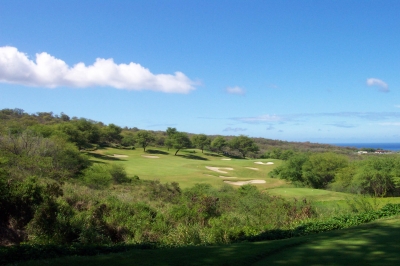 |
| The dogleg right 13th hole is the shortest par four on the inward nine, inviting you to try and drive it close -- but there are severe penalties for missing it in the wrong spot. |
Nelson describes the challenge: “It’s a difficult golf course, but it’s also very fair. There’s trouble to the sides if you’re not hitting it straight, but I think the hardest part, as far as scoring is concerned, is when you reach the greens. Because the greens are large and undulating, and you’re climbing up the hills – you get what I call ‘Rainbow putts,’ because they’re shaped like a rainbow. So if I’m looking at a putt that’s five-feet left-to-right, I’ll have it lined up a cup out… and once you’re over the ball, it’s a good idea to maybe move it two cups out. And think of that rainbow. The hardest thing is reaching the apex, that point above where you have to put it so the ball can take the slope and feed to the hole.”
An excellent description of a side-hill putt – you can take the ‘rainbow’ concept with you nearly everywhere there’re big sloped greens, but only in Hawaii is the rainbow image truly appropriate. For our first time on the greens, it was quite a challenge to garner the proper speed and line – not only are you called upon to play the course well to get there, once you’re putting your work’s far from done on the hole.
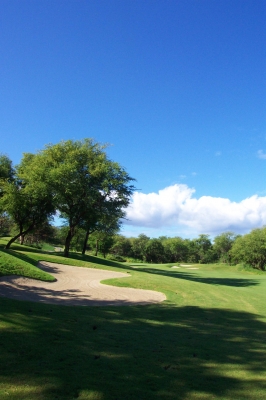 |
| Fairway bunkers and sidehill lies in the rough are waiting for you if you miss the fairway on the par four 9th hole. |
Thankfully there are some player friendly elements to the North Course that go along with the challenge and the incredible views. The fairways are more than generous, and shaped to guide balls back to the center. That won’t help if your ball flight finds the kiawe trees, but for those playing low runners, you’ll see the wisdom in the architect’s design.
Nelson was also quick to point out that there’d been some other subtle changes to the North Course recently. As time goes on, golf courses evolve, and a representative of the Jones design firm visited to check on things and make suggestions on how it might be improved. Nelson said they’ve already re-shaped the mowing patterns on some of the fairways to bring them closer to the original intent – because they’d been widened over time.
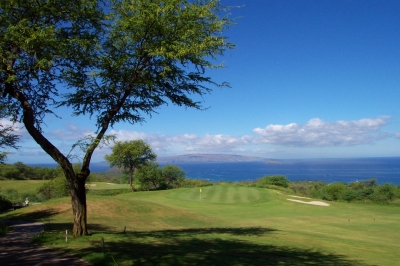 |
| Looking towards the green on the par four 11th hole. Nelson says people like to watch the whales from this hole -- and you can see why. |
Then there were the greens. “There used to be a lot more shaved edges on the greens that fell to one side – we’d gotten away from that and just had solid rough around there. So we mowed it back down to make it more like a fairway cut, where if the ball skips off the green, it’ll roll over the hill – now you’ve got a little pitch or a long putt over a nice little knob in back of the green,” Nelson explained.
One final note before describing some of the holes – Makena rates high in the service category as well. Needless to say, at a lot of places the staff is just as happy to get you to your car as you are to leave. The staff at Makena was the opposite, offering cold towels and bottled water to refresh your afternoon. A very nice touch, and we found out that several of them were students there just for the summer. Kudos to Nelson and the management for creating an atmosphere where it’s fun to serve – and the guests enjoy the benefits.
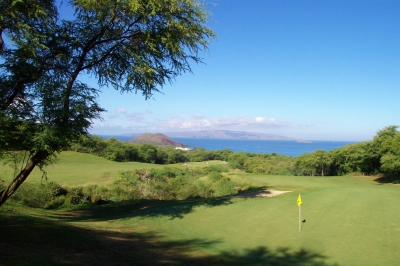 |
| There's a split fairway on the par four 6th hole. Like every good risk-reward hole, it's a much easier second shot if you choose the left-side option, but executing the tee shot is that much tougher. |
Since Nelson’s helped to create the atmosphere, we’ll leave it to him to describe the highlights. “I like the tenth green. I’ve spent many a summer afternoon late just watching those giant ‘rainbow’ putts on that green, where you can have some with 20-feet of break. You’re also reaching the top of the course there, and as you look back down that fairway, you’ve got the cinder cone, and you can see the hotel and the ocean and the other islands. It’s pretty stunning.”
He continues, “Then you’ve got the eleventh hole, where from the 150-yard marker on, you’re looking down towards the ocean. The views from that green are so spectacular, it slows up play during the whale season because people are watching them.”
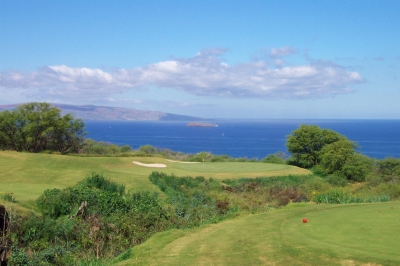 |
| Molokini provides the aiming point off the tee of the par three 12th hole. |
You’ll get more of the same excitement on twelve and thirteen, then the land drops out from under you on the par five fourteenth hole, which measures over 600 yards but drops 200 feet from tee to green. If you can place it in the right spot off the tee on this hole, it’s definitely reachable in two, even for medium length hitters. It’s also one you won’t soon forget, as your ball catches serious air from the ‘launching pad.’
And finally, the par three fifteenth hole. “When you get to the fifteenth tee, Robert Trent Jones Jr. lines up the crater right behind the green. Even though it’s not on the ocean, again, he lines it up and gives you another photo opportunity there with the island as a backdrop. It’s also the place where I witnessed a ‘double breach’ of two humpback whales – the only one I’ve ever seen,” Nelson said.
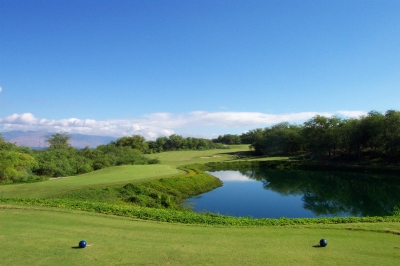 |
| From the tee box of the par four 8th hole -- it looks tighter than it really is. Hit your driver your normal distance and there's plenty of room to land it out there. |
The whales only add to the ambiance at Makena. As Nelson points out, the beauty can be distracting, but if you’re in Hawaii just to hit golf shots, somehow you’re missing the point. We’ll leave the final word to Nelson: “The North is a difficult golf course, but if people don’t mind getting their butts kicked because they’re distracted by all of the scenery… By the time they get that experience and come down and take a cold towel from the guys in the cart area and do some visiting at the end – well, it doesn’t get any better than that.”
“They’re part of the family and ready to come back. It’s really unique.”
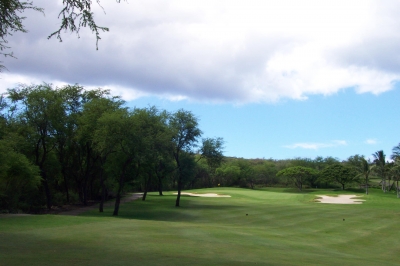 |
| Finishing up on the par four 18th hole. Favor the right side off the tee if you want an unobstructed shot into the green. |
No doubt about it. We’re definitely ready to do it again.
Note: If you’re staying on the western end of the island, at Kaanapali or Kapalua, it’s over an hour’s drive to reach Makena. But it’s worth the trip.
Details:
Makena Golf Courses’ North Course
5415 Makena Alanui
Makena,
Phone: (808) 879-3344
FAX: (808) 879-2834
Website: http://www.makenagolf.com/
Email: makena@maui.net
Designer: Robert Trent Jones Jr.
Head Golf Professional: Kirk Nelson, PGA
Tees/Yardage/Slope/Rating
Tournament 6914 139/72.1
Championship 6567 136/70.4
Resort 6151 132/68.4
Forward 5303 128/70.9
Rates:
Through 4/30/06:
Standard - $185; Non-Resort Guest - $160; Makena Resort Guest - $115; Twilight - $135 (after 1 p.m.); Twilight, Makena Resort Guest - $100 (after 1 p.m.).
From 5/1/06 – 9/30/06:
Standard - $185; Non-Resort Guest - $145; Makena Resort Guest - $110; Twilight - $125 (after 1 p.m.); Twilight, Makena Resort Guest - $95 (after 1 p.m.).
Rates include cart and range privileges. A 4.16% tax will be added to all prices.
Consult the website for information on stay and play packages.
Note: Walking is not permitted – which is probably a wise policy, based on the terrain. Walking is permitted on the South Course after 3 p.m., and it’s not a bad walk.
| Related Links | Comments on this article? | |
|
Maryland National Golf Club Hollow Creek Golf Club Rocky Gap Resort PB Dye Golf Club in Ijamsville Whiskey Creek Golf Club |
E-mail Jeff Rendall, Editor: jrendall@golftheunitedstates.com |

